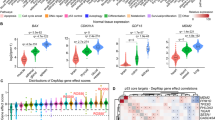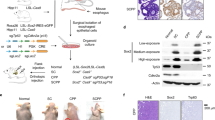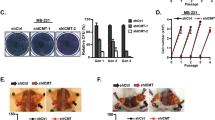Abstract
Many if not most tissues need a controlled number of stem cells to maintain normal function. Cancer can be seen as a process of disturbed tissue homeostasis, in which too many cells have or acquire too primitive identity. Here we measured how oncogenes and tumour suppressors affect the differentiation capacity, proportion and characteristics of progenitor cells in a model tissue. Neural progenitor cells (NPCs) were exposed to human papilloma virus E6, E7 or E6/E7 oncogenes, which degrade tumour suppressors p53 and pRb family members, respectively. E6/E7-expressing or p53−/− NPCs were able to differentiate, but simultaneously retained high capacity for self-renewal, proliferation, ability to remain multipotent in conditions promoting differentiation and showed delayed cell cycle exit. These functions were mediated through p53 and pRb family, and involved MEK–ERK signalling. Decreased amount of p53 increased self-renewal and proliferation, whereas pRb affected only proliferation. Our results suggest that the oncogenes increase whereas p53 and pRb family tumour suppressors decrease the number and proportion of progenitor cells. These findings provide one explanation how oncogenes and tumour suppressors control tissue homeostasis and highlight their importance in stem cell self- renewal, linked both to cancer and life-long tissue turnover.
This is a preview of subscription content, access via your institution
Access options
Subscribe to this journal
Receive 50 print issues and online access
$259.00 per year
only $5.18 per issue
Buy this article
- Purchase on Springer Link
- Instant access to full article PDF
Prices may be subject to local taxes which are calculated during checkout







Similar content being viewed by others
References
Antinore MJ, Birrer MJ, Patel D, Nader L, McCance DJ . (1996). EMBO J 15: 1950–1960.
Armstrong JF, Kaufman MH, Harrison DJ, Clarke AR . (1995). Curr Biol 5: 931–936.
Bach S, Knockaert M, Reinhardt J . (2005). J Biol Chem 280: 31208–31219.
Boyer SN, Wazer DE, Band V . (1996). Cancer Res 56: 4620–4624.
Bruggeman SW, Valk-Lingbeek ME, van der Stoop PP . (2005). Genes Dev 19: 1438–1443.
Callaghan DA, Dong L, Callaghan SM, Hou YX, Dagnino L, Slack RS . (1999). Dev Biol 207: 257–270.
Chakrabarti O, Veeraraghavalu K, Tergaonkar V . (2004). J Virol 78: 5934–5945.
Cheng S, Schmidt-Grimminger DC, Murant T, Broker TR, Chow LT . (1995). Genes Dev 9: 2335–2349.
Choi J, Donehower LA . (1999). Cell Mol Life Sci 55: 38–47.
Coursen JD, Bennett WP, Gollahon L, Shay JW, Harris CC . (1997). Exp Cell Res 235: 245–253.
Davies R, Hicks R, Crook T, Morris J, Vousden K . (1993). J Virol 67: 2521–2528.
Dazy S, Damiola F, Parisey N, Beug H, Gandrillon O . (2003). Oncogene 22: 9205–9216.
DeCaprio JA . (1999). Biologicals 27: 23–28.
Dyson N, Dembski M, Fattaey A, Ngwu C, Ewen M, Helin K . (1993). J Virol 67: 7641–7647.
Farah MH, Olson JM, Sucic HB, Hume RI, Tapscott SJ, Turner DL . (2000). Development 127: 693–702.
Favata MF, Horiuchi KY, Manos EJ . (1998). J Biol Chem 273: 18623–18632.
Fehrmann F, Laimins LA . (2003). Oncogene 22: 5201–5207.
Ferguson KL, Callaghan SM, O'Hare MJ, Park DS, Slack RS . (2000). J Biol Chem 275: 33593–33600.
Grewal SS, York RD, Stork PJ . (1999). Curr Opin Neurobiol 9: 544–553.
Halbert CL, Demers GW, Galloway DA . (1991). J Virol 65: 473–478.
Harris KF, Christensen JB, Radany EH, Imperiale MJ . (1998). Mol Cell Biol 18: 1746–1756.
Hawley-Nelson P, Vousden KH, Hubbert NL, Lowy DR, Schiller JT . (1989). EMBO J 8: 3905–3910.
Herdegen T, Skene P, Bahr M . (1997). Trends Neurosci 20: 227–231.
Liu H, Dibling B, Spike B, Dirlam A, Macleod K . (2004). Curr Opin Genet Dev 14: 55–64.
Macleod KF, Hu Y, Jacks T . (1996). EMBO J 15: 6178–6188.
Meijer L, Borgne A, Mulner O . (1997). Eur J Biochem 243: 527–536.
Miller MW, Peter A, Wharton SB, Wyllie AH . (2003). Brain Res 965: 57–66.
Molofsky AV, He S, Bydon M, Morrison SJ, Pardal R . (2005). Genes Dev 19: 1432–1437.
Molofsky AV, Pardal R, Iwashita T, Park IK, Clarke MF, Morrison SJ . (2003). Nature 425: 962–967.
Munger K, Baldwin A, Edwards KM . (2004). J Virol 78: 11451–11460.
Pardal R, Clarke MF, Morrison SJ . (2003). Nat Rev Cancer 3: 895–902.
Popsueva A, Poteryaev D, Arighi E . (2003). J Cell Biol 161: 119–129.
Ross SE, Greenberg ME, Stiles CD . (2003). Neuron 39: 13–25.
Scheffner M, Werness BA, Huibregtse JM, Levine AJ, Howley PM . (1990). Cell 63: 1129–1136.
Singh SK, Clarke ID, Terasaki M . (2003). Cancer Res 63: 5821–5828.
Slack RS, El-Bizri H, Wong J, Belliveau DJ, Miller FD . (1998). J Cell Biol 140: 1497–1509.
Slack RS, Hamel PA, Bladon TS, Gill RM, McBurney MW . (1993). Oncogene 8: 1585–1591.
TeKippe M, Harrison DE, Chen J . (2003). Exp Hematol 31: 521–527.
Toma JG, Akhavan M, Fernandes KJ . (2001). Nat Cell Biol 3: 778–784.
Toma JG, El-Bizri H, Barnabe-Heider F, Aloyz R, Miller FD . (2000). J Neurosci 20: 7648–7656.
Tyner SD, Venkatachalam S, Choi J . (2002). Nature 415: 45–53.
van Houten VM, Snijders PJ, van den Brekel MW . (2001). Int J Cancer 93: 232–235.
Vanderluit JL, Ferguson KL, Nikoletopoulou V . (2004). J Cell Biol 166: 853–863.
Walboomers JM, Jacobs MV, Manos MM . (1999). J Pathol 189: 12–19.
Whyte P, Buchkovich KJ, Horowitz JM . (1988). Nature 334: 124–129.
Acknowledgements
We thank Drs Kirsi Sainio and Anu Wartiovaara for insightful comments, Monica Shoulz for FACS flow cytometry, Lea Armassalo, Valtteri Harri, Jetta Kelppe, Virpi Syvälahti, Maria Herranen, Susanna Räsänen, Jouni Kvist and Agnes Viherä for technical support and Kimmo Tanhuanpää and Katri Jauhiainen for assistance with confocal microscopy. This research was funded by Helsinki Biomedical Graduate School, Academy of Finland, National Technology Agency of Finland (TEKES) and University of Helsinki.
Author information
Authors and Affiliations
Corresponding author
Rights and permissions
About this article
Cite this article
Piltti, K., Kerosuo, L., Hakanen, J. et al. E6/E7 oncogenes increase and tumor suppressors decrease the proportion of self-renewing neural progenitor cells. Oncogene 25, 4880–4889 (2006). https://doi.org/10.1038/sj.onc.1209492
Received:
Revised:
Accepted:
Published:
Issue Date:
DOI: https://doi.org/10.1038/sj.onc.1209492



